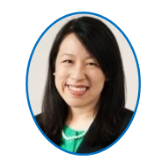Stacey was the last staff member to join the OCT in January 2023 and is our OnCore trainer and primary support specialist. Stacey manages user access and the creation of OnCore training material such as eLearning, training videos, and training documents, but she also provides overall support in the usage of OnCore. If you have created an OnCore Service Desk ticket recently, you have already communicated with Stacey. While our end-users are required to perform role-based training to gain access to OnCore, it does not have to end there. Using our OnCore Service Desk you can ask specific questions or request additional training for you or a group.
Can you provide a brief overview of your background?
I started my career in biochemical and hematological research at the University of Tennessee, Memphis, working on many projects such as prostate cancer cells, clotting factors, and DNA mutations of G-proteins. I then transitioned into a Quality Assurance/ Compliance role at St. Jude Children’s Research Hospital in Memphis, TN. While there, I initially helped with a neuroblastoma clinical research project. St. Jude then built an on-site GMP manufacturing facility where we produced the biologic drugs for St. Jude clinical trials, and I was the Quality Assurance supervisor. I helped to build the Quality / GMP program for the facility with my supervisor, the QA director. I was responsible for Quality management systems such as FDA audits, document control, compliance, and training. I was at St. Jude for 18 years until I moved home to Kentucky where I worked 2.5 years in the contract manufacturing field as a Compliance specialist, and then I moved to the University of Kentucky (UK) as a Data Analyst for the OnCore CTMS, where I was introduced to the OnCore CTMS training system and support management.
What has inspired you to take on your current role here at Mount Sinai?
Once I went from the clinical research and quality role into the contract manufacturing / pharma (for-profit) role, I decided that I really didn’t like the “big pharma” side of Quality. I wanted to get back into clinical research, but I didn’t really want the same quality assurance role that I’d done for 20+ years, and I also didn’t want to go back into the research lab itself. So when the opportunity came up to work with the CTMS (OnCore) program at UK, I was able to combine all my past experiences to be successful in the role. And that role led me here to Mount Sinai doing the same work, and I just love it!
What impact do you hope to make through your work?
When you’re introducing a new software system to everyone, their first response is “Why do I have to do this?” or “We’re already using something else”, so I’m hoping to make the use of OnCore simple enough to demonstrate how it can help the research community here at Mount Sinai. I want to show people either through demonstrations of OnCore, my training documents or training videos, that it takes a little bit of work on the front end, but overall, you’re going to get a lot more out of OnCore than you put into it. I’m hoping to make OnCore not so intimidating by showing them how it can help them, versus how they think it may cause more work. Basically I hope to provide “Process improvement” which is a big part of quality improvement and that’s what I hope to bring to my role here at Mount Sinai.
Is there any specific message that you’d like to share with our readers?
People should never be afraid to try or learn new things, because you don’t know where it’s going to lead you. When I went to college, I was going to be a pharmacist, but that didn’t work out, so I became a chemist. It’s important to realize that even though you’re good at something, that doesn’t mean that’s what you’re meant to do. So just take those chances when opportunities open, and don’t be afraid to take a leap of faith. I’ve had three totally different career paths and that is what has gotten me to this job. This is the first time in a long time during my 30 year career, where I look forward to coming to work. I look forward to meeting with my direct team every morning, and meeting with the larger department on Thursdays. I can honestly say there is not one person I have met here that I don’t enjoy working with. This is the first time that I’ve really loved what I’m doing, where I’m doing it, and all the people involved. It’s taken me 30 years to get here, but I got here, and I wouldn’t have gotten here if I hadn’t taken chances that I did.
ConduITS is supported by NCATS of the NIH’s CTSA Program. Any use of CTSA-supported resources requires citation of grant number UL1TR004419 awarded to ISMMS in the acknowledgment section of every publication resulting from this support. Adherence to the NIH Public Access Policy is also required.


